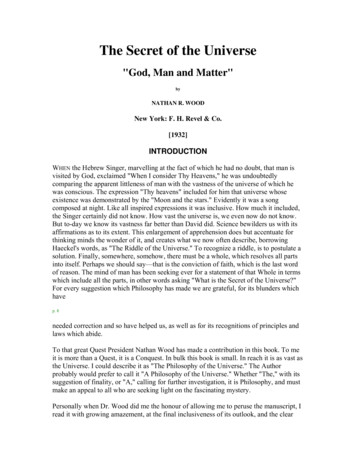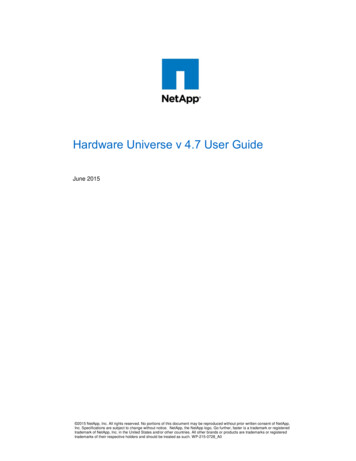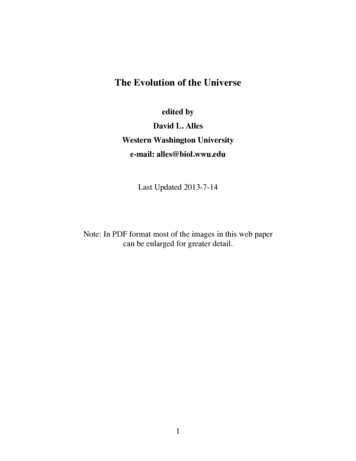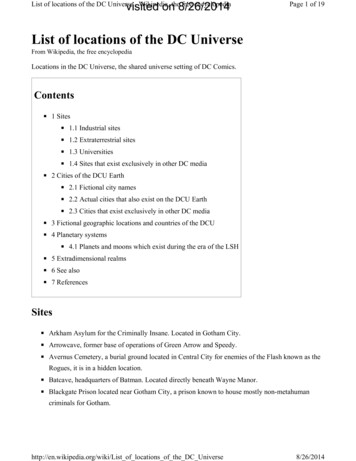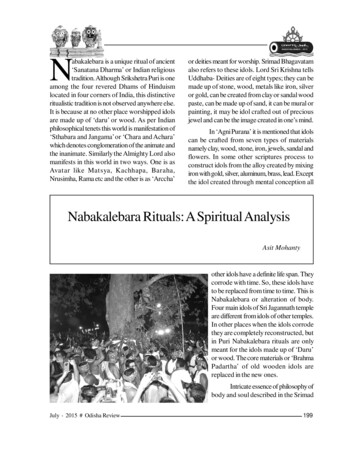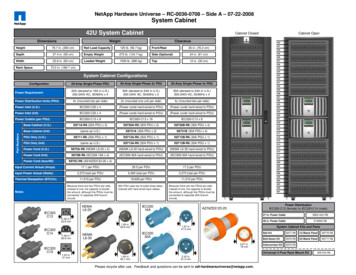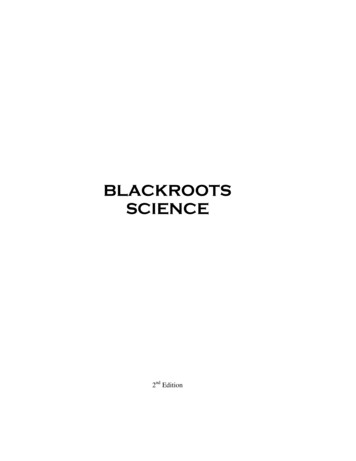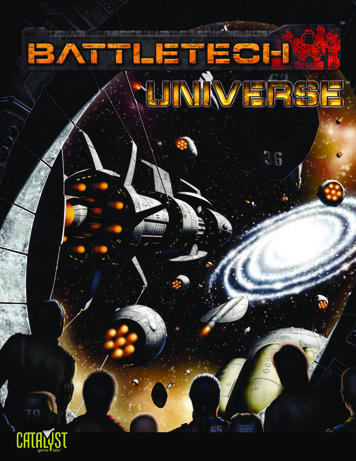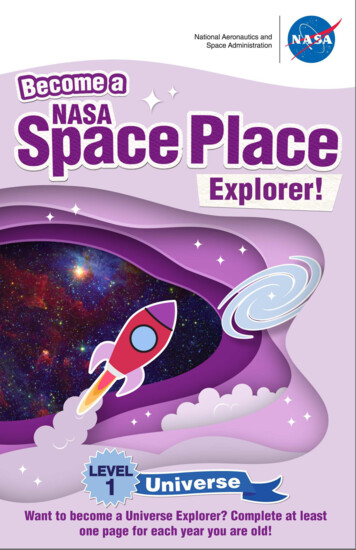
Transcription
National Aeronautics andSpace Administration :,- Wantto becomea UniverseExplorer?Completeat leastonepagefor eachyearyouare old!
What is the universe?The universe is not just stars and galaxies and planets-it iseverything. All of space, matter and energy are part of the universe.The universe even includes time itself and, of course, it includes you.--fAlthough the universe might seem like a faraway place, you're in itright now! In the box below, draw three of your favorite things in theniv:rse. People? Pets? Toys? Foods? They're all in the universe!
Where did the universe come from?The big bang is how astronomers explain the way the universe began.It is the idea that the universe began as just a single point about 13.8billion years ago. Then, it expanded and stretched. The universeeventually grew as large as it is right now.In fact, the universe is still stretching today! That doesn't mean thatplanets and stars are stretching out and getting bigger. It just meansthat the space between these objects is growing.Make your own expanding universe below. Fold accordion-style on thedotted lines below. Once the two galaxies are next to each other,you've reached the early universe! Pull on the bottom of the paper toexpand the universe and move the galaxies apart over time.
How old is it?When you think of things that are old, what do you think of?Dinosaurs? The pyramids in Egypt? Our universe is the oldest thingwe know of at 13.8 billion years old. That's a lot of birthdays tocelebrate!In the timeline below, enter the letters of each event in order fromoldest to most recent. Check your answers at the bottom when you'redone!-13.8 billion years ago'''-13.6 billion years ago'D''·- m.,:J;b'''-66 million years ago'D''-2.8 million years agoD'-245 years agoA. Dinosaurs went extinctB. The Declaration of Independence was signedC. Earth first formedD.The last ice age beganE. The Milky Way (our galaxy) first formedF. The Sun first formed8·a 'v ':J 11?.:l '3:Aa)j J8MSUl;fD
Universe Crossword234567Across1. How astronomers explain the way the universe began as a singlepoint, then expanded.3. NASA's Hubble Spacehas been sending back beautifulimages and helping scientists to learn about the universe for morethan 30 years.4. Includes everything - space, matter, energy and even time.5. Agency makes satellites and rockets, and sends humans and robotsinto space to study the Earth, Moon, Mars, the solar system and theUniverse.7. A huge collection of gas, dust and billions of stars and their solarsystems, all held together by gravity.Down2. Our universe formed 13.8years ago.6. A sphere of gas held together by its own gravity. The closest one toEarth is our Sun.
How do we study the universe?Scientists use telescopes to study the objects in our universe. NASAuses space telescopes to look at some of the oldest parts of theuniverse - distant galaxies that formed shortly after the big bang.The Hubble Space Telescope has been producing beautiful images ofour universe for more than 30 years. NAS.A:snext big telescope - theJames Webb Space Telescope - will be a giant leap forward in ourquest to understand the universe and where we came from. It willexamine the history of our universe from the Big Bang to theformation of our own solar system.Color a picture of the Webb telescope below! e 0. . . . . . . .41t
Different types of galaxiesA galaxy is a huge collection of gas, dust and stars - as well as theplanets that orbit those stars. A galaxy is held together by gravity. Welive in a galaxy called the Milky Way, but there are many others. Somescientists think there could be as many as one hundred billiongalaxies in the universe.There are different types of galaxies. Our Milky Way is a spiral galaxy.Spiral galaxies have curved arms that make them look like apinwheel. Other galaxies are smooth and oval shaped. They're calledelliptical galaxies. And there are also galaxies that aren't spirals orovals. They have irregular shapes and look like blobs.Sort through this galaxy of letters to find the words below!K M E C B M V E VK V H O SQF R G J TW N H W F A A M LS D K L H L W F K U L L M F UQ G Z Z M K I T O A R U N A ZY J M U P Y K L X M O G H I XW Q X C L W D Y G T R E D B IF A O L O A D Q U O M R P C YVR S S Y C O L U U R V X HP S Z R Z T YY U SC H VN K H V Q T A U T P W Z C E PNURTGD XZH AR NF X"'dustDVDSXHUDNLHSUFAGTDZRZMZRISRAXP SII EC BJ BPWLMRGFRLGFUSJ Eelliptical galaxy gravity irregularMilky Way spiral starsBCPVM
What is a black hole?A black hole is a region of such immense gravity that nothing - noteven light - can escape from it. NASA missions such as Chandra,NuSTAR and Swift help to capture information that is useful forunderstanding black holes.There is a black hole at the center of most galaxies, including ourhome galaxy, the Milky Way. Draw a line from dot to dot in numberorder to make an image of a spiral galaxy and its black hole.8 19 5 10 477 46 2040 37 36 39 2641e49 345e50.e3514 2 1.12 4213 24 22 1529 23 30 33 32
What is a constellation?A constellation is a group of stars that looks like a particular shapein the sky and has been given a name. These stars are far away fromEarth. They are not connected to each other at all. But, if you were todraw lines in the sky between the stars - and use lots of imagination- the picture would look like an object, animal or person. Usually thenames and shapes of constellations relate to stories and myths fromdifferent cultures.Stars and constellations appear to stay in approximately the samespot for many, many years. Because the constellations appear to bein a fixed location, they are often used as landmarks in the sky. So,NAS.A:srobotic spacecraft use maps of the stars to find their way.They carry a star map in their onboard computers and compare thesestar maps to patterns of stars in images they take.Make and name your own constellations in the field of stars below!***** .**.* * * .*** * * ** * * *.*** * ***.** *.****t
What is a nebula?A nebula is a giant cloud of dust and gas in space. In fact, nebula isthe ancient Greek word for "cloud." Some nebulae (more than onenebula) come from the gas and dust thrown out by the explosion of adying star, such as a supernova. Other nebulae are regions wherenew stars are beginning to form.Astronomers use very powerful telescopes such as NASA's HubbleSpace Telescope to capture images of faraway nebulae.A nebula is where newborn stars call home. What environment dothese baby animals call home? Match the animal baby to its homebelow
Are there other planets outside of our solar system?Yes! All of the planets in our solar system orbit around the Sun.Planets that orbit around other stars are called exoplanets. There areeven some exoplanets that don't orbit a star at all. NASA scientistshave discovered thousands of exoplanets in our universe - andthey're finding new ones all the time.Exoplanets are too far away from Earth to visit. But we can learn a bitabout what they are like by using powerful telescopes, such as theTransiting Exoplanet Survey Satellite.Pretend that you've just discovered an exoplanet and you need to logyour discovery in your notebook. What does your planet look like?What is it like there? Tell the other scientists all about your planet inthe space below!Draw what this planetlooks like belowPlanet name:Discovered----------by:(your name here)How does this planet compareto Earth? (circleSize: SmallerLargerTemperature: ColderWarmerThe groundone)Same sizeAbout the sameon this planet is made of:The sky on this planet is:(color)Do you think somethingcould live here?(circle one)YesNoThis new planet smells like:Is there waterYeson this planet? (circleNoNot sureone)
Is there life on other planets?Scientists haven't found life beyond Earth yet. But they have found afew places where it might be possible! Planets that can support life arein what's called the habitable zone.A habitable zone planet is exactly the right distance from its star. Atthis distance, the planet is warm enough to have liquid water on itssurface, which is essential for life as we know it. In our solar system,Earth sits comfortably inside the Sun's habitable zone.Find words that are important to the search for life in the puzzle below!LuyLppL K D sX 0 F IL F 0 s GQ 0 E p Dp F G LC L L X HV 0 D L EEuBA z V X XB p D y VQK M Kw H p B HA T F y VT R X L QE A E B sR E C E EJ s Qp 0 EL s pR Q X RR D I FA RLB N QCpuA QWWC JX pN AT DB KR EuN AIE CN CE 0RwA D z0 E GC 0M F uV M GG B FuwG y s J Hy K L A QT EH T W B B A GA E sGpR C 0 TMRA M 0 0 N sM G EC B X NL D FsGH p s 0 M T A ,liquid waterlifemoonsstar
What is space made of?Believe it or not, planets, stars, galaxies, comets and black holes areonly a small part of the universe. The rest of the universe is made upof other stuff that we don't really understand. Scientists call it darkmatter and dark energy.Dark matter is stuff in space that has gravity, but it is unlike anythingscientists have ever seen before. Dark energy is the force we can'treally see that is making the universe expand.Lots of scientists are using observations and math to figure out whatdark matter and dark energy are. Can you use math to solve thispuzzle? Complete the four puzzle boxes below. Every row, column andblock must contain the numbers 1 through 4 once.3441123243141222443231422431311312
All about lightSpace is a dark place! What brings the light? Stars, of course! Ourown star, the Sun, is what lights up the daytime on Earth. When youlook at the sky on a dark night, you can see the light from other stars,too.But light that we can see - called visible light - is only one kind ofenergy released by stars. There are other kinds of light energy, too.They are called radio waves, microwaves, infrared, visible light,ultraviolet light, X-rays and Gamma-rays. Together, these energy typesmake up what is called the electromagnetic spectrum.NASA scientists use different types of telescopes to detect differenttypes of light. This helps us learn more about the stars and galaxies inour universe. We use these different kinds of light energy on Earth, too.Follow the paths below to match each energy type to its use on Earth.Radio11111InfraredVisibleX-rays
How far away?Stars - like our Sun - produce light and energy. NAS.A:sspacetelescopes look at the light from these stars to learn about how old thestars are and what they are made of. We also use light to measure howfar away the stars are.Have you ever heard the term "light-year"? A light-year is used tomeasure very long distances. One light-year is equal to the distancethat light can travel in one year - 5.8 trillion miles (9.4 trillionkilometers).Imagine you're a light wave. How long would it take you to travel aroundthe universe? Do the math problems below to see how far away thesethings are!EarthIIIIIIIIIIII'',',,20 0 250,.,, IIIIIlight ',,,,years',,,5-:-2'- millionlightyearsIIIThe NorthStar, Polaris IAndromedaGalaxy(our closestneighboring galaxy)
ChecklistDDDDDDDDDDDDDDPage 1 - What is the universe?Page 2 - Where did the universe come from?Page 3 - How old is it?Page 4 - Universe crosswordPage 5 - How do we study the universe?Page 6 - Different types of galaxiesPage 7 - What is a black hole?Page 8 - What is a constellation?Page 9 - What is a nebula?Page 10 - Are there other planets outside of our solar system?Page 11 - Is there life on other planets?Page 12 - What is space made of?Page 13 - All about lightPage 14 - How far away?1.How many activities did you do?2.How old are you?When answer 1 is greater than or equal to answer 2, you're a UniverseExplorer!Ready for more? Head over to our spaceplace.nasa.gov to playgames, do activities and learn more about our planet, our solarsystem, our galaxy and our universe!Front cover: Spitzer reveals the Carina Nebula, which contains Eta Carinae, a star that's 100 timesas massive and a million times as bright as our sun. Photo: NASA/JPL-Caltech/M. Pavich, PennState Univ.Back cover: The magnificent spiral arms of the nearby galaxy Messier 81 are highlighted in thisNASA Spitzer Space Telescope image. Photo: NASA/JPL-Caltech
Formoreinformation,visit the aceplace NASASpacePlaceTwitter: .gov
A galaxy is a huge collection of gas, dust and stars - as well as the planets that orbit those stars. A galaxy is held together by gravity. We live in a galaxy called the Milky Way, but there are ma
